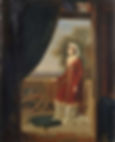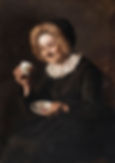What Are the Different Types of Portrait Artwork?
- Vishakha
- Apr 5, 2024
- 6 min read
Updated: Sep 16
Just like us humans, portraits too, come in all shapes and sizes. Portrait artworks are one of the most common types of paintings and have been loved by artists for ages. Several portraits have been created in history, either on request, commissioned, or simply an interest of the artist themselves. You might have also come across portraits of different types.

However, did they ever make you wonder why portrait art is just focused on the face of the subject whereas others capture their full body? Why do some of them have a single individual whereas others have a group painted? Have you ever asked yourself what these different types of portraits are called? If you just answered yes, then this blog is just for you. Today, we’ll cover all the different types of portraits there are and what makes them unique.
Types of Portraits
There are several types of portraits and all of them can be segregated into different categories. These categories are classified based on the length of the painting, the number of subjects in the portrait, the posture of the subject, etc.
Portrait Artworks Based on the Length of the Painting
This is one of the oldest ways of classifying portrait artworks. It consists of 5 different types.
1. Full-length portraits

As you might have already guessed these portraits include the full body of the subject in the frame. These portraits were quite popular during the aristocratic era of 17th century Europe when royals preferred depicting their full body on the canvas. Their standing posture signified their rank in the court. Since these portraits also include a background or surroundings of the subject in the frame, they are usually more colorful with defined context.
2. Half-length portraits
These portrait artworks depict only the upper half of the subject, usually from the waist up. The subjects in these portraits are usually found sitting or standing and are the focus of the painting. The background of these paintings is not of much significance here and is preferably kept monochromatic. Portrait artists usually draw half-length portraits on canvas using oil paints or watercolors. Since these portraits put the subject in focus, they have been quite popular since the Renaissance period and are loved even today.
3. Three-quarter portraits
As the name suggests, these portraits only depict the subject till their knee-length. Three-quarter portraits are a combination of full-length and half-length portraits. They make a hybrid use of background, the posture of the subject, and the entire context of the composition. However, these portrait artworks are not very popular because they give an incomplete appearance of the subject.
4. Bust-view portraits
Bust — the face, neck, and a little glimpse of the chest is what a bust-view portrait is all about. These portraits are also called head and shoulder portraits with complete focus on the face and neck of the subject. This brings the viewer’s attention to the facial profile of the subject, the subtleties, and intricacies in their facial expression. With such emphasis on the face in these portrait artworks, it doesn’t leave much room for a significant background.
5. Kit-cat portraits

Kit-Cat portraits are essentially a different version of half-length portraits. However, these portraits end much above the waistline and make it a point to depict the hands of the subject in the frame. The interesting name of these portraits originated after the famous Kit Cat Club of noteworthy poets and writers in London. The club commissioned the portrait of these notable figures to be hung in the club. They were all painted by Sir Godfrey Kneller, who took over twenty years to complete all these portraits. All the portraits were thirty-six inches by twenty-eight inches in dimensions. This is how the famous kit cat portraits came into existence.
Portrait Artworks Based on the Pose of the Subject
There can be various poses a subject can maintain for a portrait artwork. These poses can be classified into 4 different types.
1. Profile view portraits
These types of portraits do not depict the full frontal face view of the subject. They instead focus on the facial profile or the whole body of the subject. These portraits are popular for depicting famous personalities from history. They depict the subject at an angle which adds more depth to the painting.
2. Full-face view portraits
When a portrait depicts the full frontal face of a subject in the frame, it is called a full-face view. The subjects in these portraits usually look directly in the eyes of the viewer, as if talking to them directly. Whereas in other portraits, artists paint their subject in such a way they seem to be looking far behind the viewer. However, in either case, the highlight of these portraits is always the details of the face. These portraits are also quite popular in photography.
3. Three-quarter view portraits
Three-quarter view portraits are between the profile view and the full-frontal view. It is an angle between the two of these poses. The head of the subject is slightly turned towards the viewer. It’s angled in such a way that makes them directly look at the viewer or a distance from the canvas. This portrait has been quite popular among artists who create self-portraits.
4. Tronie

Tronies were born during the Dutch Golden Age and were intended to express natural human expressions. Before this age, artists were prohibited from expressing the natural human expression by a strict law. Even the people of the Netherlands were quite scared of casually posing for a portrait. Tronie is a term for head, face, and expressions, making it a study of facial expressions. The position of the head can also be quite varying, depending on what expressions the artist wanted to portray. However, they weren’t rigid like the regular portraits anymore.
Portrait Artworks Based on the Number of People
This is the final type of classification that segregates the portraits based on the number of subjects in the painting.
1. Individual Portraits
It is a single-person portrait highlighting the life of the subject, their facial features, or their social ranking. These are some of the most commonly created portrait artworks. They are also created to celebrate the major accomplishments of an individual or as a visual memorial of a deceased person.
2. Double Portraits
If you add another individual to a portrait, it becomes a double portrait. They are quite an effective medium to depict the bond between two individuals — especially couples. However, they can also be used to portray the relationship between any two individuals. These portraits also convey a much deeper meaning than individual portraits. They can be used to show the contrast or similarities between two individuals which can convey a lot more than just the faces of two people.
3. Self-portraits

You can call them the older versions of what we now call selfies. If you haven’t already guessed, these portraits depict the artist as the subject. This means when artists create their own portraits they are called self-portraits. They are a type of individual portraits but can be considered a special genre in this category. Many famous artists in history have created self-portraits that now act like their memoirs.
4. Group portraits
When there are more than two people in a portrait, it is called a group portrait. However, what differentiates a group portrait from a landscape is that it focuses merely on the group and no other distractions. A common example of a group portrait is a family portrait where every individual is related to each other in some manner. Every individual in the portrait can pose as per their choice and still complement each other in some manner.
The Overlap of Portrait Artworks
With time, the techniques and interpretations of art have matured. Due to the changing faces of portrait art, there has been overlap and they cannot be classified as a single type of portrait anymore. A half-length portrait can also be an individual portrait and a tronie at the same time.
A good portrait artist can also capture and convey the mood/temperament of the subject with their brush skills. It is not an easy job, but can be made to look quite appealing to the viewers. We at TERAVARNA are often on the lookout for such artists and wish to see them shine through our portrait art competition. If you think you have the skills to capture the human essence of your subjects on your canvas, we are waiting to see your artistry.